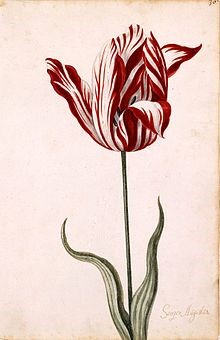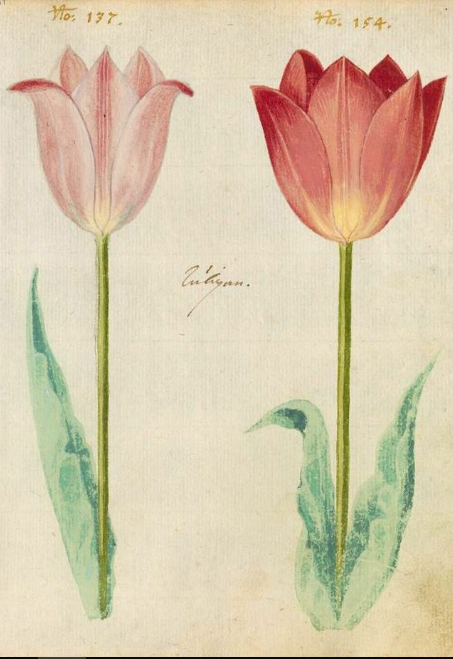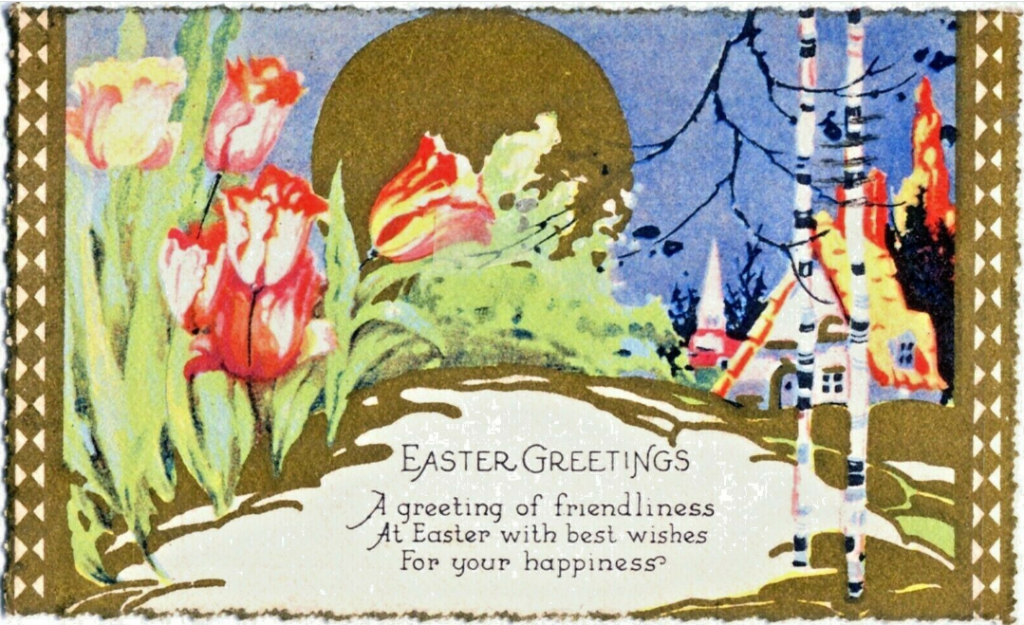The Tulip Mania of 1637
[Editor’s Note] In a recent Internet search of Big Box stores that sell garden supplies, I found tulip bulbs sell for approximately three to eight cents apiece. Keep this in mind while you ponder the inevitable question; if only … ?

You may have heard about the War of the Roses, but when people are asked if they know about the 1637 Tulip Mania, they stare in bewilderment. To say the least, the Tulip Mania was one of the most bizarre economic events in all of western civilization, and a fine explanation follows, but first let me tell you about the image on the postcard you see here. It is that of the Semper Augustus tulip. It is famous for being the most expensive tulip sold during the tulip mania of March 1637, when one tulip bulb of this variety sold for the sum of 5000 florins. Adjusted to current (2013) US dollars that is $2,500.
The following account of Tulip Mania authored by Cynthia Wood is fascinating.

The later part of the 20th century saw its share of odd financial bubbles. There was the real estate bubble, some stock market bubbles, and the dot-com bubble, just to name a few. In each instance of price inflation people paid exorbitant amounts for things that shouldn’t have been worth anything like the going price. And, each time people stood around afterwards and asked themselves, “What was I thinking?”
One must believe that the same thought occurred to the Dutch in the 17th century when they settled down after their bout with tulip mania, wherein the humble tulip bulb began to sell for prices to make New York realtors blush.
As much as the tulip is associated with Holland, it is not native there. Tulips were introduced to the Dutch in 1593 by a botanist named Carolus Clusius, who brought it from Constantinople. He planted a small garden, intending to research the plant for medicinal purposes. Had Clusius’s neighbors been morally upright, the tulip might still be a rare exotic in the gardening world, but instead they broke into his garden and stole his bulbs in order to make some quick money, and in the process started the Dutch bulb trade.

Over the next several decades, tulips became a fad among the rich of Holland, and prices began to mount. Soon even ordinary bulbs were selling for extraordinary prices, and the rare bulbs were astronomical. A single Viceroy Tulip bulb would sell for 2500 florins a value roughly equivalent to $1,250 in current American dollars, while a rarer Semper Augustus bulb could easily go for twice that. One particularly amusing exchange showed the goods traded for one bulb – the lengthy list included, among other things: a bed, a complete suit of clothes, and a thousand pounds of cheese. At the height of the mania, in what seems a complete loss of sanity, the bulbs were deemed too valuable to risk planting. With some of the wealthiest purchasers it became popular to display the plain ungrown bulbs on mantelpieces and sideboards. In at least one instance, the plan for safety backfired when a visiting sailor to a high end boarding establishment in Amsterdam mistook a tulip bulb for an onion and proceeded to eat it for breakfast.
The height of the bubble was reached in March 1637. Tulip traders were making (and losing) fortunes regularly. A good trader could earn a year’s salary in one month. With such profits, there was nothing local governments could do to stop the trading frenzy.
Then one day in Haarlem a buyer failed to show up and pay for his bulb purchases. The ensuing panic spread across Holland, and within days, tulip bulbs were worth only a hundredth of their former prices. The tulip bubble had burst.
Some additional facts:
- There is a board game designed by Scott Nicholson, an international board game historian, called Tulipmania 1637, speculation in the first Bubble Market. Introduced in 2009, it won an award for the best board game of the year. It currently is on sale at Amazon.com for $72.00.
- There are two bestselling books about the event. The best is Tulipomania: the Story of the World’s Most Coveted Flower & the Extraordinary Passions It Aroused by Mike Dash.
- Several historical romance novels mention the mania and feature characters who were genuine participants.

I did a little research in this. Found that whilst there was a mania for tulips it wasn’t the reason for the collapse of the Dutch economy but rather showed the endemic gambling nature of investors. Basically it was part of what we have now with investments in derivatives or futures markets if you like.
I think the best historical guess is that 1 gold florin at that time would convert to about $60 today.
I have seen estimates as high as 1 florin (guilder) being the equivalent of about $150. There is a historical transaction at that time period of 32 florin being used to purchase 1,008 gallons of beer.
I have also read that the highest price paid for a bulb was 5,500 florin. A little math makes that one bulb selling for somewhere between $330,000 to as high as $825,000. Trying to estimate conversion rates from a 400 year old currency isn’t perfect but it sold for vastly more than $2,500 in today’s currency.
Money in the 17th century Netherlands This reference source I found lines up with Brians’s remarks, the calculate 1 florin/guilder is roughly 60 USD today (page dated 2016). from Investopedia In 1634, tulipmania swept through Holland. “The rage among the Dutch to possess [tulip bulbs] was so great that the ordinary industry of the country was neglected, and the population, even to its lowest dregs, embarked in the tulip trade.” A single bulb could be worth as much as 4,000 or even 5,500 florins – since the 1630’s florins were gold coins of uncertain weight and quality it is hard to make… Read more »
This is so inaccurate. A skilled artisan could make 300 gilder (florin) a year then. Some of these single bulbs at the height of the insanity sold for close to 5,000 gilder. If we assume that a skilled artisan (carpenter) can make $60,000 a year, that 1 bulb could have been worth the equivalent of $1,000,000.00 now. No currency conversion needed.